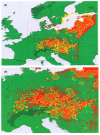Earth observation, geographic information systems and Plasmodium falciparum malaria in sub-Saharan Africa
- PMID: 10997207
- PMCID: PMC3164801
- DOI: 10.1016/s0065-308x(00)47009-0
Earth observation, geographic information systems and Plasmodium falciparum malaria in sub-Saharan Africa
Abstract
This review highlights the progress and current status of remote sensing (RS) and geographical information systems (GIS) as currently applied to the problem of Plasmodium falciparum malaria in sub-Saharan Africa (SSA). The burden of P. falciparum malaria in SSA is first summarized and then contrasted with the paucity of accurate and recent information on the nature and extent of the disease. This provides perspective on both the global importance of the pathogen and the potential for contribution of RS and GIS techniques. The ecology of P. falciparum malaria and its major anopheline vectors in SSA in then outlined, to provide the epidemiological background for considering disease transmission processes and their environmental correlates. Because RS and GIS are recent techniques in epidemiology, all mosquito-borne diseases are considered in this review in order to convey the range of ideas, insights and innovation provided. To conclude, the impact of these initial studies is assessed and suggestions provided on how these advances could be best used for malaria control in an appropriate and sustainable manner, with key areas for future research highlighted.
Figures










References
-
- Anderson JF, Andreadis TG, Vossbrinck CR, et al. Isolation of West Nile virus from mosquitoes, crows, and a Cooper’s hawk in Connecticut. Science. 1999;286:2331–2333. - PubMed
-
- Anderson RM, May RM. Infectious Diseases of Humans: Dynamics and Control. Oxford University Press; Oxford: 1991a. A framework for discussing the population biology of infectious diseases; pp. 13–23.
-
- Anderson RM, May RM. Infectious Diseases of Humans: Dynamics and Control. Oxford University Press; Oxford: 1991b. Indirectly transmitted microparasites; pp. 374–429.
-
- Aniedu I. Dynamics of malaria transmission near two permanent breeding sites in Baringo District. Indian Journal of Medical Research. 1997;105:206–211. - PubMed
-
- Anonymous . Malaria Areas in the Union of South Africa. Union of South Africa, Department of Public Health; Pretoria: 1938.
Publication types
MeSH terms
Grants and funding
LinkOut - more resources
Full Text Sources
Research Materials
